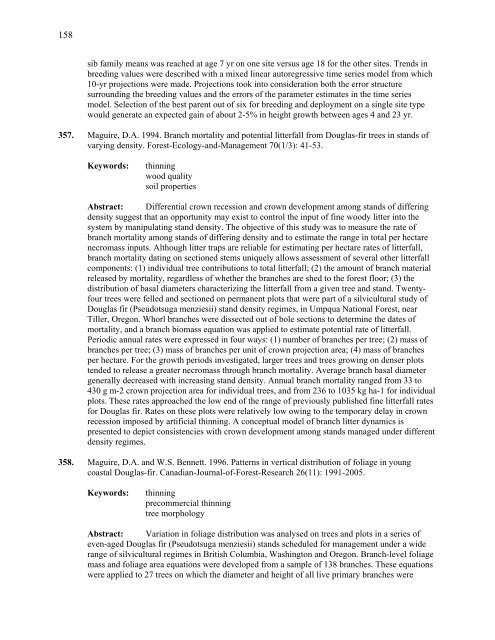IntensIve sIlvIculture - Forest Science Labs - Research Network ...
IntensIve sIlvIculture - Forest Science Labs - Research Network ...
IntensIve sIlvIculture - Forest Science Labs - Research Network ...
Create successful ePaper yourself
Turn your PDF publications into a flip-book with our unique Google optimized e-Paper software.
158<br />
sib family means was reached at age 7 yr on one site versus age 18 for the other sites. Trends in<br />
breeding values were described with a mixed linear autoregressive time series model from which<br />
10-yr projections were made. Projections took into consideration both the error structure<br />
surrounding the breeding values and the errors of the parameter estimates in the time series<br />
model. Selection of the best parent out of six for breeding and deployment on a single site type<br />
would generate an expected gain of about 2-5% in height growth between ages 4 and 23 yr.<br />
357. Maguire, D.A. 1994. Branch mortality and potential litterfall from Douglas-fir trees in stands of<br />
varying density. <strong>Forest</strong>-Ecology-and-Management 70(1/3): 41-53.<br />
Keywords: thinning<br />
wood quality<br />
soil properties<br />
Abstract: Differential crown recession and crown development among stands of differing<br />
density suggest that an opportunity may exist to control the input of fine woody litter into the<br />
system by manipulating stand density. The objective of this study was to measure the rate of<br />
branch mortality among stands of differing density and to estimate the range in total per hectare<br />
necromass inputs. Although litter traps are reliable for estimating per hectare rates of litterfall,<br />
branch mortality dating on sectioned stems uniquely allows assessment of several other litterfall<br />
components: (1) individual tree contributions to total litterfall; (2) the amount of branch material<br />
released by mortality, regardless of whether the branches are shed to the forest floor; (3) the<br />
distribution of basal diameters characterizing the litterfall from a given tree and stand. Twentyfour<br />
trees were felled and sectioned on permanent plots that were part of a silvicultural study of<br />
Douglas fir (Pseudotsuga menziesii) stand density regimes, in Umpqua National <strong>Forest</strong>, near<br />
Tiller, Oregon. Whorl branches were dissected out of bole sections to determine the dates of<br />
mortality, and a branch biomass equation was applied to estimate potential rate of litterfall.<br />
Periodic annual rates were expressed in four ways: (1) number of branches per tree; (2) mass of<br />
branches per tree; (3) mass of branches per unit of crown projection area; (4) mass of branches<br />
per hectare. For the growth periods investigated, larger trees and trees growing on denser plots<br />
tended to release a greater necromass through branch mortality. Average branch basal diameter<br />
generally decreased with increasing stand density. Annual branch mortality ranged from 33 to<br />
430 g m-2 crown projection area for individual trees, and from 236 to 1035 kg ha-1 for individual<br />
plots. These rates approached the low end of the range of previously published fine litterfall rates<br />
for Douglas fir. Rates on these plots were relatively low owing to the temporary delay in crown<br />
recession imposed by artificial thinning. A conceptual model of branch litter dynamics is<br />
presented to depict consistencies with crown development among stands managed under different<br />
density regimes.<br />
358. Maguire, D.A. and W.S. Bennett. 1996. Patterns in vertical distribution of foliage in young<br />
coastal Douglas-fir. Canadian-Journal-of-<strong>Forest</strong>-<strong>Research</strong> 26(11): 1991-2005.<br />
Keywords: thinning<br />
precommercial thinning<br />
tree morphology<br />
Abstract: Variation in foliage distribution was analysed on trees and plots in a series of<br />
even-aged Douglas fir (Pseudotsuga menziesii) stands scheduled for management under a wide<br />
range of silvicultural regimes in British Columbia, Washington and Oregon. Branch-level foliage<br />
mass and foliage area equations were developed from a sample of 138 branches. These equations<br />
were applied to 27 trees on which the diameter and height of all live primary branches were
















